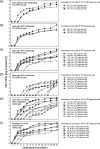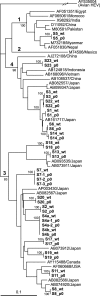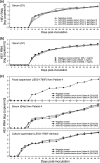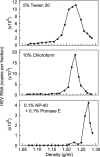Hepatitis E Virus (HEV) strains in serum samples can replicate efficiently in cultured cells despite the coexistence of HEV antibodies: characterization of HEV virions in blood circulation
- PMID: 20107086
- PMCID: PMC2849599
- DOI: 10.1128/JCM.02002-09
Hepatitis E Virus (HEV) strains in serum samples can replicate efficiently in cultured cells despite the coexistence of HEV antibodies: characterization of HEV virions in blood circulation
Abstract
We recently developed a cell culture system for hepatitis E virus (HEV) in PLC/PRF/5 and A549 cells, using fecal specimens from HEV-infected patients. Since transfusion-associated hepatitis E has been reported, we examined PLC/PRF/5 and A549 cells for the ability to support replication of HEV in various serum samples obtained from 23 patients with genotype 1, 3, or 4 HEV. HEV progenies emerged in culture media of PLC/PRF/5 cells, regardless of the coexistence of HEV antibodies in serum but dependent on the load of HEV inoculated (31% at 2.0 x 10(4) copies per well and 100% at >or=3.5 x 10(4) copies per well), and were successfully passaged in A549 cells. HEV particles in serum, with or without HEV antibodies, banded at a sucrose density of 1.15 to 1.16 g/ml, which was markedly lower than that for HEV particles in feces, at 1.27 to 1.28 g/ml, and were nonneutralizable by immune sera in this cell culture system. An immuno-capture PCR assay of HEV virions treated with or without detergent indicated that HEV particles in serum are associated with lipids and HEV ORF3 protein, similar to those in culture supernatant. By immunoprecipitation, it was found that >90% of HEV particles in the circulation exist as free virions not complexed with immunoglobulins, despite the coexistence of HEV antibodies. These results suggest that our in vitro cell culture system can be used for propagation of a wide variety of HEV strains in sera from various infected patients, allowing extended studies on viral replication specific to different HEV strains.
Figures







References
-
- Arankalle, V. A., and L. P. Chobe. 2000. Retrospective analysis of blood transfusion recipients: evidence for post-transfusion hepatitis E. Vox Sang. 79:72-74. - PubMed
-
- Boxall, E., A. Herborn, G. Kochethu, G. Pratt, D. Adams, S. Ijaz, and C. G. Teo. 2006. Transfusion-transmitted hepatitis E in a ‘nonhyperendemic’ country. Transfus. Med. 16:79-83. - PubMed
-
- Chandra, V., S. Taneja, M. Kalia, and S. Jameel. 2008. Molecular biology and pathogenesis of hepatitis E virus. J. Biosci. 33:451-464. - PubMed
-
- Dalton, H. R., R. Bendall, S. Ijaz, and M. Banks. 2008. Hepatitis E: an emerging infection in developed countries. Lancet Infect. Dis. 8:698-709. - PubMed
Publication types
MeSH terms
Substances
Associated data
- Actions
- Actions
- Actions
- Actions
- Actions
- Actions
- Actions
- Actions
- Actions
- Actions
- Actions
- Actions
- Actions
- Actions
- Actions
- Actions
- Actions
- Actions
- Actions
- Actions
- Actions
- Actions
- Actions
- Actions
- Actions
- Actions
- Actions
- Actions
- Actions
- Actions
- Actions
- Actions
- Actions
- Actions
- Actions
- Actions
- Actions
- Actions
- Actions
LinkOut - more resources
Full Text Sources
Other Literature Sources

